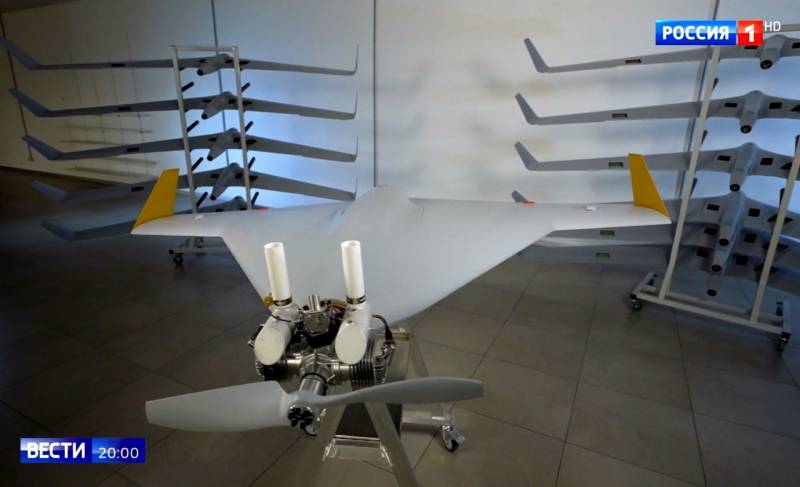Can the Italmas UAV become an effective hunter of Ukrainian air defense systems and MLRS
One of the most intriguing new products of the domestic military-industrial complex, generated by the experience of a special operation in Ukraine, is a new Russian kamikaze drone, bearing the unusual and slightly jarring name “Italmas”. What kind of drone is this and what potential might be hidden in it?
Between "Cube" and "Geranium"
The new Russian attack drone became known only recently, after President Putin’s visit to the Aeroscan enterprise, the parent organization of the Zala Aero group, a leading developer of domestic drones. Then, as if by chance, a drone glider, devoid of accompanying equipment, appeared in the frame of the video camera. As it later turned out, it was an Izdeliye 54, or Italmas, UAV. Let us note that the new drone is always shown to us from above and we will reflect on the reasons for this at the end of the review.
“Italmas”, and in the Udmurt language this is the name of the herbaceous plant, considered the symbol of the republic, is built according to the “flying wing” scheme, and composite materials are used in its assembly. The two-blade propeller is not a pusher, like the Geranium, but a puller. All together, this reduces the visibility of the UAV on radar. The internal combustion engine is, judging by some signs, of Chinese origin. Fuel reserves are located in the wings. As the Ukrainian military, who have already encountered Italmas, note in their public pages, when flying, the new Russian drone makes a sound similar to a switched-on chainsaw, not a moped.
From what we have been able to find out from open sources, Italmas has a flight range of up to 200 km. Thus, in terms of its performance characteristics, it finds itself in an intermediate position between the similar “Cube” and “Geranium”. At the same time, like “Cube”, “Italmas” can also do the so-called slide before the attack, пишет profile Telegram channel “UAV Developer”:
The motor is too small for the Shahed. And the nature of its work is fundamentally different from geranium. Judging by the sound, “Italmas” makes a slide before the attack, just like “Kub” did.
There are no exact data, but the expert community has suggested that the shorter-range and powerful Italmas will also be cheaper than the Geranium. However, this commercial advantage pales in comparison to the possibilities that open up if the new Russian drone is indeed, as expected, equipped with an overview video camera.
Between Harpy and Harop?
By themselves, disposable kamikaze drones do not represent technical point of view of something particularly complex. However, among them there is a subspecies that is extremely urgently needed by the Russian army in the Northern Military District zone. These are loitering munitions that have the functions of anti-radar hunters and reconnaissance weapons.
The Israelis were the first to create a homing projectile called Harpy back in the late 80s of the last century. Using a container-type mobile launcher, they launched loitering drones that patrolled a given space, looking for active enemy radars, and when detected, quickly, like harpies, dived at them, destroying them with a high-explosive fragmentation warhead.
A further development of this concept can be considered the Harop UAV, developed in the early 2000s. Its distinctive external feature from its predecessor can be considered the presence in the nose of a radar and a digital camera with a 360-degree viewing angle and high resolution. The drone is also designed primarily to combat enemy air defense systems, but it is far from disposable.
It is implied that Harop is a reconnaissance drone capable of turning into a kamikaze if necessary. The UAV is also launched from a container-type mobile unit and is capable of patrolling a given area for a long time, conducting aerial reconnaissance. Having detected the SAM radar, the drone turns into an attacker and self-destructs along with it. If there is no worthy goal, then it can automatically return to base for repeated use.
Israeli Harops were actively used by the Azerbaijani army during the second Nagorno-Karabakh war and showed their high efficiency. Russian Armed Forces UAVs with similar performance characteristics would be extremely useful for hunting enemy air defense systems, as well as American long-range MLRS, which are a real headache.
I remember in May 2023 we voiced the idea of equipping Geranium-type kamikaze drones with a homing head from the X-58 missile, which would turn them into Harpy-type anti-radar drones. This would make it possible to pin the Ukrainian air defense to the ground and clear more of the sky for the Russian Aerospace Forces. However, Russia now has the Italmas, which appears to be more in line with the Harop reconnaissance and strike drone. Let's quote profile Telegram channel “Russian Engineer”:
The presence of a camera on board the Italmas will greatly complicate the life of the rear of the Ukrainian Armed Forces; hunting for air defense is now possible far from the LBS. And not only air defense, of course, although, in general, this is the highest priority target for hitting with a drone... For everything else there is VKS.
According to some reports, in its lower part, which they prefer not to show on TV, the new Russian drone may have an overview video camera, which would allow it to be used for aerial reconnaissance, as well as as a kamikaze. If this information is confirmed in practice, our capabilities to suppress enemy air defense and counter-battery warfare to a front depth of up to 200 km will soon increase sharply.

Information